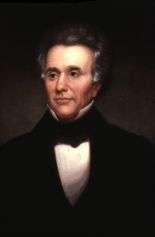Reuben H. Walworth
| Reuben Walworth | |
|---|---|
 | |
| Chancellor of New York | |
|
In office April 28, 1828 – July 5, 1847 | |
| Governor |
Nathaniel Pitcher Martin Van Buren Enos Throop William Marcy William Seward William Bouck Silas Wright John Young |
| Preceded by | Samuel Jones |
| Succeeded by | Position abolished |
| Member of the U.S. House of Representatives from New York's 12th district | |
|
In office March 4, 1823 – March 3, 1825 | |
| Preceded by | Ezra C. Gross |
| Succeeded by | Lewis Eaton |
| Personal details | |
| Born |
October 26, 1788 Bozrah, Connecticut, U.S. |
| Died |
November 27, 1867 (aged 79) Saratoga Springs, New York, U.S. |
| Political party |
Democratic-Republican (Before 1828) Democratic (1828–1867) |
| Spouse(s) | Maria Avery (Deceased 1848) |
| Children |
Clarence Mansfield |
Reuben Hyde Walworth (October 26, 1788, Bozrah, New London County, Connecticut – November 27, 1867, Saratoga Springs, Saratoga County, New York) was an American lawyer and politician. He was the last Chancellor of New York, in office from 1828 to 1847, at the time the highest judicial officer in the State.
Life
Walworth was the son of Benjamin Walworth and Apphia (Hyde Cardell) Walworth. The family removed to Hoosick, New York, when Reuben was still a child. He studied law at Troy, was admitted to the bar in 1809, and commenced practice in Plattsburgh. On January 16, 1812, he married Maria Ketchum Averill (1795–1847).
Walworth was elected as a Democratic-Republican to the 17th United States Congress, holding office from December 3, 1821, to March 3, 1823. In April 1823, Walworth was appointed as Judge of the Fourth Circuit Court, and in October removed to Saratoga Springs. In 1828, Walworth was appointed Chancellor of New York, and remained in office until July 1847 when the office was abolished by the State Constitution of 1846.
Walworth gained President John Tyler's attention because of his widely respected opinions on evidence, pleadings, civil procedure, and arbitration. Tyler nominated him to the Supreme Court of the United States three times in 1844, but the nomination was always postponed due to Tyler's lack of support from both Whigs and the Democrats.
In 1848, Walworth was the Hunkers' candidate for Governor of New York, but was defeated in a three-way race by Whig Hamilton Fish. In 1850, Walworth was asked by the Supreme Court to serve as a special master in the case of Pennsylvania v. Wheeling and Belmont Bridge Company. In 1851, he married Sarah Ellen (Smith) Hardin, widow of Congressman John J. Hardin (1810–1847).
Walworth was a Freemason, and served as Grand Master in the Grand Lodge of New York in 1853.
He was for a long period president of the American Temperance Union. He was also vice-president of the Bible Society and the Tract Society. Princeton University gave him the degree of LL.D. in 1835. He was the author of Rules and Orders of the New York Court of Chancery (Albany, 1829; several revised eds.), and Hyde Genealogy (2 vols., 1864). He was elected a member of the American Antiquarian Society in 1865.[1]
Walworth was buried at Greenridge Cemetery in Saratoga Springs.
His son Clarence A. Walworth (1820–1900) converted to Catholicism and was a founding member of the Paulist Fathers.
His other son Mansfield Tracy Walworth (1830–1873) married Ellen Hardin (the daughter of his stepmother), and was shot dead by their son Francis Hardin "Frank" Walworth (b. 1853).
Walworth County, Wisconsin and Walworth, New York were named for him.
References
- The Oxford Companion to the Supreme Court of the United States, Kermit L. Hall ed., New York, 1992.
Sources
- United States Congress. "Reuben H. Walworth (id: W000118)". Biographical Directory of the United States Congress.
- Political Graveyard
- Court History
- The New York Civil List compiled by Franklin Benjamin Hough (pages 71, 353, 356; Weed, Parsons and Co., 1858)
- Hyde Genealogy by Reuben Hyde Walworth (published by Joel Munsell, Albany, 1863; pages 533ff)
| United States House of Representatives | ||
|---|---|---|
| Preceded by Ezra C. Gross, Nathaniel Pitcher |
Member of the U.S. House of Representatives from New York's 12th congressional district 1823–1825 with Nathaniel Pitcher |
Succeeded by Lewis Eaton |
| Legal offices | ||
| New seat | Judge of the New York Fourth Circuit Court 1823–1828 |
Succeeded by Esek Cowen |
| Preceded by Samuel Jones |
Chancellor of New York 1828–1847 |
Succeeded by Freeborn G. Jewett as Chief Judge of the New York Court of Appeals |
| Party political offices | ||
| Preceded by Silas Wright 1846 |
Democratic (Hunker) nominee for Governor of New York 1848 with John Adams Dix (Barnburner) |
Succeeded by Horatio Seymour 1850 |